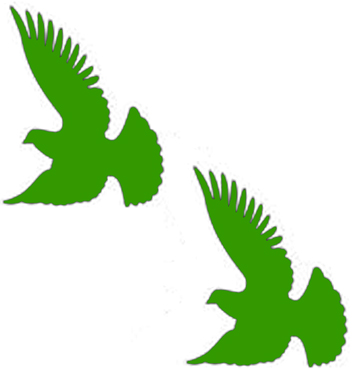Front Runners
A number of you have asked me what kind of birds I fly since I have moved to Florida, and since you have seen my results changing. You have asked about specific strains. I have not given you a clear-cut answer since there really is none. But what I have done is kept my Meulemans base family and added some additional front-runner capabilities. I honestly don't know if this front-runner phenomenon exists anywhere else in the pigeon racing world. But here in Spring Hill FL, which I think we can safely say is the most competitive and strongest level of flying in the United States, this front-runner effect exists almost every week.
Here you very seldom, if ever, get a single pigeon to win a race clear-cut. What you do get every week is a group of birds, be it 15 or 25, that will be 30 or 40 seconds in front of the 2000 birds competing. They will be followed by another wave of 20 to 30 birds 30 to 40 seconds later. And then the waves of birds just keep coming. What you have to understand is that this first wave of birds comes with a tremendous speed and intensity.
A new flyer or someone who has never had the quality of bird that maintains the tempo of that early group just plain does not understand what is going on, and will make the comment that we fly clocking contests here. Yes, it is a clocking contest, but only amongst a small group of birds. This is why we always tell you that no one is able to clock a bird on the front page on every race of a season, "front page" meaning the first 50 pigeons.
These front-runner birds usually are capable of flying a few times per season at this rate and intensity. And you will get a bird here and there to do this. But once you study this closer, you will find that certain birds repeat this process and even more important, that those birds originate out of certain birds. Of course a bird that flies with that kind of all-out effort and intensity is easily mis-managed and can fall by the wayside.
In 2003 we had 3 exceptional birds that flew in this category at the GHC. I believe 2 of them were first to their respective lofts 6 times and one was 5 times first to its loft. Of course those 3 birds tormented the rest of us on race day, and of course their numbers always appeared on the big board pools. But you have to understand, there were only 3 birds capable of doing this out of about 20,000 youngsters that are settled and compete here every year. The lead bird of these was a CBS-bred bird, 856, that was flown by Carter Mayotte and now belongs to Bill Welch. That bird became the Hall of Fame pigeon of the United States in the category of 100 lofts and up. 856's parents now reside in our stock loft.
Keeping in mind that we were looking for front-runner type of pigeons, in 2002 we were fortunate to get our hands on two exceptional Casaert birds that are cousins. Casaert is a smaller loft in Flanders that has accomplished the unbelievable feat of winning three First Nationals. To win one First National is a lifetime dream of the smaller Belgian lofts, and to do it three times is incredible. Now add to this that the first time Casaert did this in 1992, he entered only one pigeon (Invincible Montauban) in this big competition from Montauban. In 2000, he repeated the same feat, entering only one bird (Nasdaq) and winning First National Souillac vs. 7154 birds. And then in 2004 he entered only 3 birds and Mistral won First National Brive. All 3 of these First National front-runner winners are very closely related. In fact, Mistral is a grandson of the Nasdaq.
Ernst Nebel, author of Champions of the World, spent the better part of week with us here in Florida. I asked him what kind of birds were exceptional in the world at this time. He could not come up with a family or group of birds for me, but then told me that he had on order 4 youngsters from the wonder pigeon Figo.
The Figo was considered the best middle distance pigeon in the world by people in the know in 2001. This phenomenal pigeon repeatedly beat his competition by clearly flying up front, winning by minutes in a very competitive area. His big win was First National Bourges vs. 12, 266 birds. He was not the only bird to have this unbelieveable ability to fly out front. Two of his brothers had also been the Ace Middle Distance Pigeon of Westflanders. For three consecutive years this Ace Middle Distance Pigeon honor was won by three brothers, something that had never been done before.
Then in 2004, the coveted National Bourges was won by a Belgian fancier who had purchased Figo blood. The sire of the winning bird was a son of a full brother of the Figo. In 2005, the Dutch organized a national anniversary race celebrating 75 years of their national organization. This race was flown from Lemars, France, with the huge entry of 120,936 birds. The winner of this headwind race was bred out of a Belgian cock, none other than another full brother of the Figo.
In 2002, we were finally able to get 2 late-bred daughters of the Figo, and they certainly have added another dimension to our loft. I think it is safe to say that we own the most direct children of the Figo in the United States.
The phenomenal thing is that the two Casaerts and the two Figos all have bred front-runner winners for us with multiple mates, something that I always look for before classifying a bird as an exceptional breeder.
